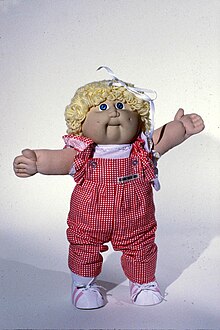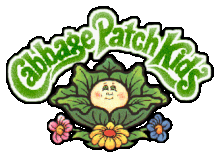
Coleco Industries, Inc. was an American company founded in 1932 by Maurice Greenberg as The Connecticut Leather Company. It was a successful toy company in the 1980s, mass-producing versions of Cabbage Patch Kids dolls and its video game consoles, the Coleco Telstar dedicated consoles and ColecoVision. While the company ceased operations in 1988 as a result of bankruptcy, the Coleco brand was revived in 2005, and remains active to this day.

Mattel, Inc. is an American multinational toy manufacturing and entertainment company founded in Los Angeles by Harold Matson and the husband-and-wife duo of Ruth and Elliot Handler in January 1945 and headquartered in El Segundo, California. Mattel has a presence in 35 countries and territories; its products are sold in more than 150 countries. Mattel consists of three business segments: North America, International and American Girl.

Hasbro, Inc. is an American multinational conglomerate holding company incorporated and headquartered in Pawtucket, Rhode Island. Hasbro owns the trademarks and products of Kenner, Milton Bradley, Parker Brothers, and Wizards of the Coast, among others. As of August 2020, over 81.5% of its shares were held by large financial institutions.
Rainbow Brite is a media franchise by Hallmark Cards, introduced in 1984. The animated Rainbow Brite television series first aired in 1984, the same year Hallmark licensed Rainbow Brite to Mattel for a range of dolls and other merchandise. A theatrical feature-length film, Rainbow Brite and the Star Stealer, was released by Warner Bros. in 1985. The franchise was rebooted in 2014 with a three part mini-series released on Hallmark's online streaming video service, Feeln. A line of new merchandise by Hallmark online and in its shops debuted in 2015.
Xavier Roberts is best known for Cabbage Patch Kid dolls, once immensely popular soft sculpted dolls.

Cabbage Patch Kids: Adventures in the Park is a 1984 action/platform game based on the Cabbage Patch Kids franchise. It is the first and only game in the Cabbage Patch Kids Adventures series.

Lewis Galoob Toys, Inc., was a toy company headquartered in South San Francisco, California. They are best known for creating Micro Machines, which accounted for 50% of its sales in 1989, and distributing the Game Genie in the United States.
Play Along Toys was a Florida-based toy company, and a wholly owned division of Jakks Pacific.

MGA Entertainment Inc. is a manufacturer of children's toys and entertainment products founded in 1979. Its products include Bratz, Num Noms, Lalaloopsy, and Rainbow High, as well as toys targeted at boys such as Scan2Go. MGA also owns Little Tikes and animation studio MGA Studios.
Arnold Greenberg is an American businessman best known as the CEO of Coleco in the 1970s and 1980s. He began his career in law but joined Coleco, a family toy business, in 1966. He worked aggressively to gain a large share of the video game market while maintaining Coleco's position as a manufacturer of other toys. Greenberg's drive to develop and market the Adam Computer in 1982 and 1983 eventually led the company into bankruptcy.

Ideal Toy Company was an American toy company founded by Morris Michtom and his wife, Rose. During the post–World War II baby boom era, Ideal became the largest doll-making company in the United States. Their most popular dolls included Betsy Wetsy, Toni, Saucy Walker, Shirley Temple, Miss Revlon, Patti Playpal, Tammy, Thumbelina, Tiny Thumbelina, and Crissy. The company is also known for selling the Rubik's Cube.
Jay Foreman is an American businessman who lives and works in Boca Raton, Florida. He is president and CEO of Basic Fun!, which began as The Bridge Direct in 2009. Basic Fun! and its related companies, Good Stuff, K'nex, Uncle Milton, and PlayHut, design, develop and market toys for children and adult collectors. The company's product portfolio includes internally developed brands like Mash'ems and Cutetitos, as well as licensed product lines from major entertainment companies, sports leagues and other toy companies, such as Mattel and Hasbro. In 2020 the company relaunched Tonka and Care Bears, which can now be found at major retailers around the world.

Toy safety is the practice of ensuring that toys, especially those made for children, are safe, usually through the application of set safety standards. In many countries, commercial toys must be able to pass safety tests in order to be sold. In the U.S., some toys must meet national standards, while other toys may not have to meet a defined safety standard. In countries where standards exist, they exist in order to prevent accidents, but there have still been some high-profile product recalls after such problems have occurred. The danger is often not due to faulty design; usage and chance both play a role in injury and death incidents as well.
PlayMonster is a manufacturer and marketer of family entertainment products that specializes in games, children's puzzles, toys, activities, and teaching tools. As of February 2016, Patch changed its company name to PlayMonster.
Monster High is an American multimedia-supported fashion doll franchise created by toy designer Garrett Sander and launched by Mattel in 2010. The show is aimed at children ages 7-14, the franchise features characters inspired by monster movies, sci-fi horror, thriller fiction, folklore, myths and popular culture, centering around the adventures of the teenage children of monsters and other mythical creatures attending a high school of the same name.

Roger L. Schlaifer is an American graphic designer, writer, inventor and licensing agent. He is best known for his creative development and worldwide licensing of Cabbage Patch Kids and the name and works of Andy Warhol.
The Cabbage Patch riots were a series of violent customer outbursts at several retail stores in the United States in the fall and winter of 1983. That year, the Cabbage Patch Kids toy line had been released for sale in the United States, causing a tremendous demand for the product. Most stores at the time typically only stocked between two and five hundred of the product, yet with thousands of customers surging the store attempting to obtain one of the dolls, many fought with other customers in order to obtain one of the products.
Furskins was a series of plush toy bears in different sizes and guises created by Xavier Roberts in the 1980s. Furskins are a highly collectible item, yet are not as highly sought by collectors as Robert's most notable creation Cabbage Patch Kids.
Martha Nelson Thomas was an American folk artist, known for her work in soft sculpture. Thomas was the creator of "Doll Babies," later plagiarised as Cabbage Patch Kids.












